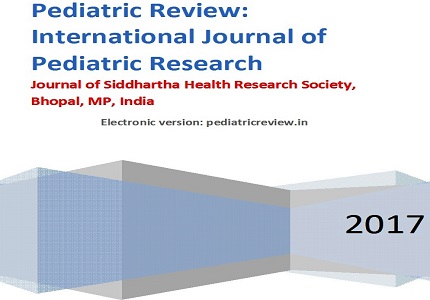Early marker of motor developmental delay in preterm infants
Keywords:
Developmental delay, General movements, Preterm infants
Abstract
Early markers of motor delay which have been studied include antenatal characteristics of mother and perinatal variables likeheart rate variability, responsiveness to stimulation, motor function, behavioral state and infant size.
Downloads
Download data is not yet available.
References
1. Johnson, S., Evans, T. A., Draper, E. S., Field, D. J., Manktelow B. N., Marlow, N., et al. Neurodevelopmental outcomes following late and moderate prematurity: a population-based cohort study. Arch Dis Child Fetal Neonatal Ed 2015;100:F301–F308. doi:10.1136/archdischild-2014-307684.
2. Rugolo LM. Growth and developmental outcomes of the extremely preterm infant. J Pediatr (Rio J). 2005 Mar;81(1 Suppl):S101-10. [PubMed]
3. Greene MM1, Patra K, Nelson MN, Silvestri JM. Evaluating preterm infants with the Bayley-III: patterns and correlates of development. Res Dev Disabil. 2012 Nov-Dec;33(6):1948-56. doi: 10.1016/j.ridd.2012.05.024. [PubMed]
4. Blauw-Hospers CH, Hadders-Algra M. A systematic review of the effects of early intervention on motor development. Dev Med Child Neurol 2005; 47: 421–432. doi:10.1111/j.1469-8749.2005.tb01165.x
5.Michael K. Georgieff, Judy C. Bernbaum, Marsha Hoffman-Williamson, Andrea Daft. Abnormal Truncal Muscle Tone as a Useful Early Marker for Developmental Delay in Low Birth Weight Infants. Pediatrics, May 1986, 77(5). [PubMed]
6. Prechtl HF Qualitative changes of spontaneous movements in fetus and preterm infant are a marker of neurological dysfunction. Early Hum Dev. 1990;23151- 158.doi.org/10.1016/0378-3782(90)90011-7.
7. Yuge M, Marschik PB, Nakajima Y, Yamori Y, Kanda T, Hirota H, Yoshida N, Einspieler C. Movements and postures of infants aged 3 to 5 months: to what extent is their optimality related to perinatal events and to the neurological outcome? Early Hum Dev. 2011 Mar;87(3):231-7. doi: 10.1016/j.earlhumdev.2010.12.046.
8. Craig, C., Grealy, MnLee, D. Detecting motor abnormalities in preterm infants; Exp Brain Res (2000) 131:359–365. DOI 10.1007/s002219900227.[PubMed]
9. Cross J, Eastman D, Brovender S, Ward MJ. Intolerance to Prone Positioning as a Clinical Marker of Motor Delay in Infants. J Pediatr Child Care. 2017;3(1): 06.
10. Coker-Bolt. P, Woodbury. M, Perkel. J, Moreau. N, Hope. K, Ramakrishnan. V, Mulvihill. D, Jenkins. D. Identifying premature infant at high and low risk for motor delays using motor performance testing and MRS.Journal of Pediatric Rehabilitation Medicine: An Interdisciplinary Approach 7 (2014) 219–232 219DOI 10.3233/PRM-140291.
11. Diwanmal SB, Dharmayat SR., Biradi MK, Vanaki RN., Pol RR, Yelamali BC. Predicting the effectiveness of Test of Infant Motor Performance as an early marker of motor development delay in preterm infants. IntJ PediatrRes. 2017;4(09):572-579.doi:10. 17511/ijpr.2017.09.06.
2. Rugolo LM. Growth and developmental outcomes of the extremely preterm infant. J Pediatr (Rio J). 2005 Mar;81(1 Suppl):S101-10. [PubMed]
3. Greene MM1, Patra K, Nelson MN, Silvestri JM. Evaluating preterm infants with the Bayley-III: patterns and correlates of development. Res Dev Disabil. 2012 Nov-Dec;33(6):1948-56. doi: 10.1016/j.ridd.2012.05.024. [PubMed]
4. Blauw-Hospers CH, Hadders-Algra M. A systematic review of the effects of early intervention on motor development. Dev Med Child Neurol 2005; 47: 421–432. doi:10.1111/j.1469-8749.2005.tb01165.x
5.Michael K. Georgieff, Judy C. Bernbaum, Marsha Hoffman-Williamson, Andrea Daft. Abnormal Truncal Muscle Tone as a Useful Early Marker for Developmental Delay in Low Birth Weight Infants. Pediatrics, May 1986, 77(5). [PubMed]
6. Prechtl HF Qualitative changes of spontaneous movements in fetus and preterm infant are a marker of neurological dysfunction. Early Hum Dev. 1990;23151- 158.doi.org/10.1016/0378-3782(90)90011-7.
7. Yuge M, Marschik PB, Nakajima Y, Yamori Y, Kanda T, Hirota H, Yoshida N, Einspieler C. Movements and postures of infants aged 3 to 5 months: to what extent is their optimality related to perinatal events and to the neurological outcome? Early Hum Dev. 2011 Mar;87(3):231-7. doi: 10.1016/j.earlhumdev.2010.12.046.
8. Craig, C., Grealy, MnLee, D. Detecting motor abnormalities in preterm infants; Exp Brain Res (2000) 131:359–365. DOI 10.1007/s002219900227.[PubMed]
9. Cross J, Eastman D, Brovender S, Ward MJ. Intolerance to Prone Positioning as a Clinical Marker of Motor Delay in Infants. J Pediatr Child Care. 2017;3(1): 06.
10. Coker-Bolt. P, Woodbury. M, Perkel. J, Moreau. N, Hope. K, Ramakrishnan. V, Mulvihill. D, Jenkins. D. Identifying premature infant at high and low risk for motor delays using motor performance testing and MRS.Journal of Pediatric Rehabilitation Medicine: An Interdisciplinary Approach 7 (2014) 219–232 219DOI 10.3233/PRM-140291.
11. Diwanmal SB, Dharmayat SR., Biradi MK, Vanaki RN., Pol RR, Yelamali BC. Predicting the effectiveness of Test of Infant Motor Performance as an early marker of motor development delay in preterm infants. IntJ PediatrRes. 2017;4(09):572-579.doi:10. 17511/ijpr.2017.09.06.

CITATION
DOI: 10.17511/ijpr.2017.i09.01
Published: 2017-09-30
How to Cite
Dr. Rabindran, & Dr D. Sharad Gedam. (2017). Early marker of motor developmental delay in preterm infants. Pediatric Review: International Journal of Pediatric Research, 4(9), 544-545. https://doi.org/10.17511/ijpr.2017.i09.01
Section
Editorial
Copyright (c) 2017 Author (s). Published by Siddharth Health Research and Social Welfare Society

This work is licensed under a Creative Commons Attribution 4.0 International License.


 OAI - Open Archives Initiative
OAI - Open Archives Initiative


